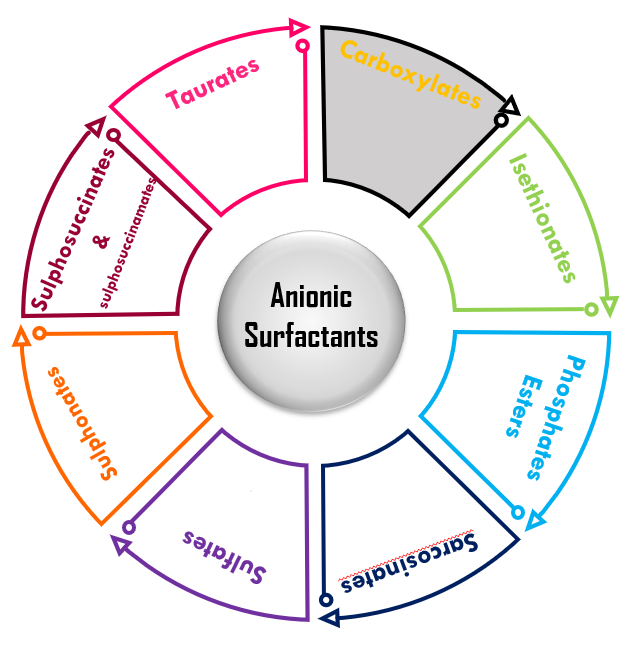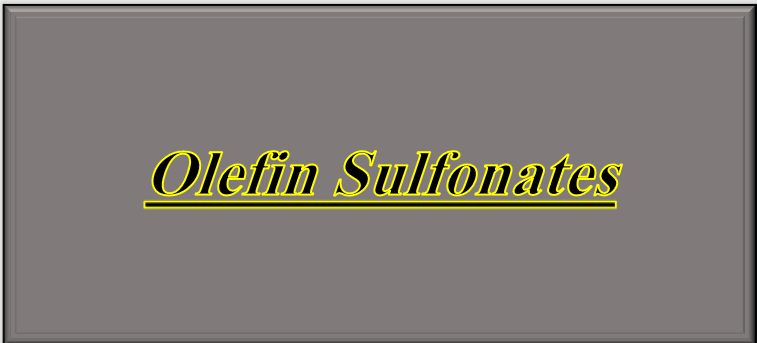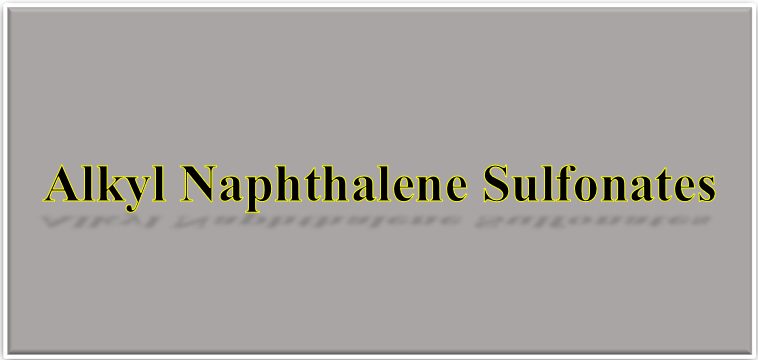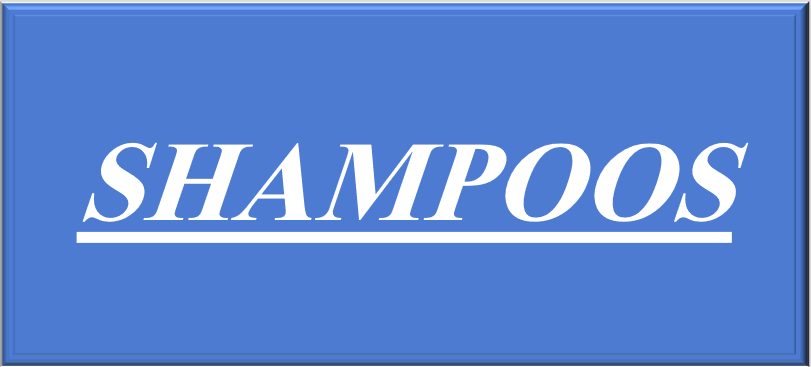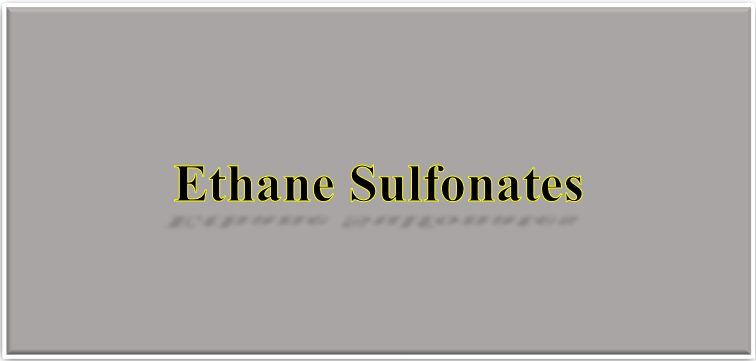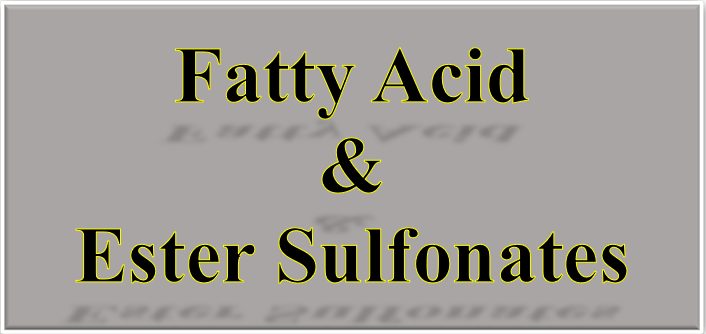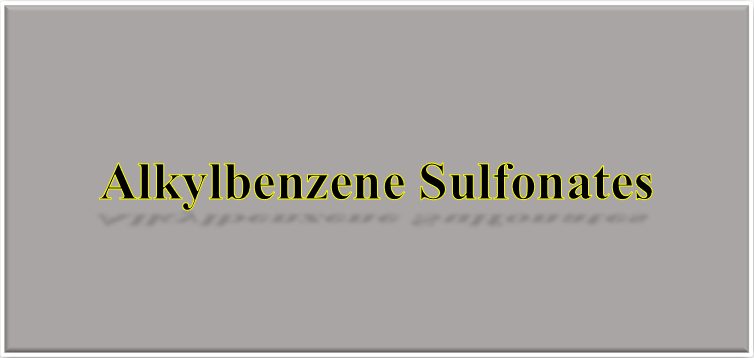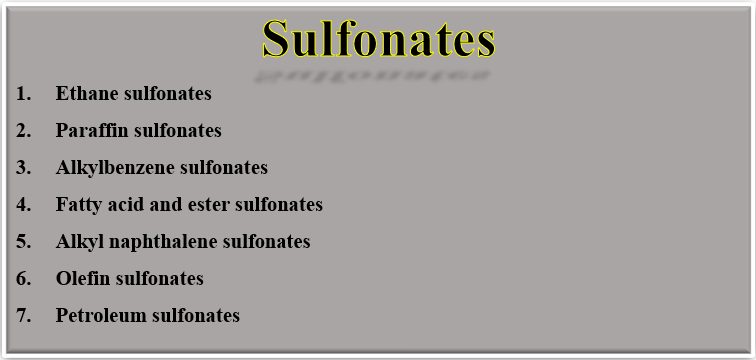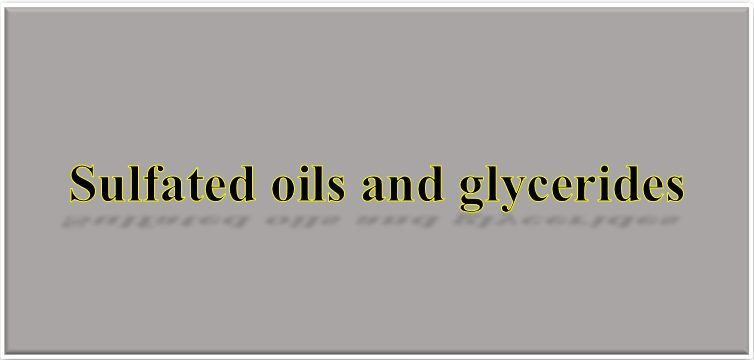Carboxylates are those surfactants with the hydrophilic (ionic) group being a carboxyl group, -COOH.
Soaps are the alkaline earth salts of the carboxylic acids of fatty acids. There are now commercially available modified carboxylates with additional functional groups. These have improved solubility in hard water.
- Ethoxy carboxylates: addition of the polyoxyethylene chain. The general structure is RO(CH2CH20).CH2COO-
- Ester carboxylates: addition of a hydroxyl or multi -COOH groups.
- Sarcosinates: addition of an amide group. Products with the general structure RCON(R’)COO-.
- Half ester sulphosuccinates: addition of a sulfate group.
- Betaines: addition of an amine group.
Soaps:
Soaps are the alkaline earth salts of the carboxylic acids of fatty acids.
The most important soap-forming fatty acids are, from a practical point of view: C12 (dodecyl) straight-chain saturated acid; C14 (myristyl) straight-chain saturated acid; Cl8 (stearic) straight-chain saturated acid; Cl8 (oleic) straight-chain, singly unsaturated acid. It is no coincidence that below C8 the products are very soluble in water, between C8 and C18 sparingly soluble, and above C20 insoluble in water. Optimum surface-active properties are obtained with the sparingly soluble products. Most commercial soaps, e.g. the tablet of soap with which you wash your hands, will be a mixture of fatty acids obtained from tallow, coconut oil, palm oil, etc.
Soap has the following attractive features:
- Widely produced and used in very large volume
- It is an excellent detergent
- The raw materials are independent of the price and availability of petroleum
- Biodegrades very readily
- Toxicology well known
The big disadvantage of soaps is their instability towards heavy metal ions, particularly the calcium and magnesium salts found in hard water, and also their instability towards acids. In both cases the end result is the same, the soap comes out of aqueous solution because of the low aqueous solubility of either the calcium and magnesium salt or the free fatty acid. This shortcoming was possibly the most important single factor in stimulating the development of the newer synthetic surface-active agents.
Generic Nomenclature:
- Soap
- Carboxylic acid salts
Examples:
Tallow soap, sodium salt of a mixture of carboxylic acids made from tallow Tall oil soap, sodium·salt of a mixture of carboxylic acids made from tall oil For the names of all the commonly occurring fatty acids.
Description:
Soaps are produced on a very large scale by a very small number of manufactures by the saponification of natural oils and fats. The most common carboxylates produced are:
- Tallow soaps, i.e. soaps produced from tallow (oleic 40-45%, palmitic 25-30%, stearic 15-20%)
- Coconut soaps, i.e. soaps produced from coconut oil (C12 48%, C14 17-20%, C16 8-10%, oleic 5-6%)
- Oleic soaps, i.e. soaps produced from olein
- Tall oil soaps, i.e. soaps produced from tall oil (mixture of fatty acids and rosin acids from wood). Distilled tall oil (DTO) usually consists of 25-30% rosin acids, 70-75% fatty acids (composition: saturated 5%; oleic acid 25%; linoleic acid and other unsaturates 70%). Tall oil fatty acids are acids of similar composition but with rosin contents of 1-10%.
- Coconut acid (the starting material for many surfactants) has the following composition:
| C12 (lauric acid) | 46-50% |
| C14 (myristic) | 17-20% |
| Cl6(palmitic acid) | 8-10% |
| C8 (caprylic acid) | small amounts |
| C10 (capric acid) | small amounts |
| Cl8(oleic acid) | small amounts |
Stripped coconut fatty acids are often described as lauric acid.
- Naphthenates occur in crude petroleum and are complex mixtures of linear C6 and C7 acids plus alkyl and alkyl carboxyl substituted cyclic pentanes. Products used as surfactants have molecular weight 250-350. Once widely used but now being phased out of surfactant applications.
General properties:
Solubility:
C12 saturated soaps soluble in water, C18 soaps very slow to dissolve. C16-C18 unsaturated soaps are soluble in water. The potassium salts of soaps are more soluble than the sodium (this is the opposite to sulfates where the potassium salt is more insoluble). The alkanolamine salts (MEA, DEA and TEA) have better solubility. The TEA salts of lauric acid and oleic acid are milder than the sodium salts, more soluble and have better foaming properties.
Tall oil fatty acids (i.e. made with unsaturated acids) are more water-soluble and give lower viscosity solutions than those from tallow.
Chemical properties:
Insoluble in aqueous solution below pH 7 due to the formation of the water-insoluble free fatty acid.
Compatibility with aqueous ions:
All the soluble salts are readily insolubilized by electrolytes and salted out, e.g. by NaCI, etc. Soaps do not perform well in hard water (reduction in solubility and foaming ability) because of the insolubility of the calcium and other divalent and trivalent salts. Acts as builders in conjunction with anionic/non-ionics.
Surface active properties:
CMC C12(saturated) sodium salt molecular weight 222.3 = 2.6×10-2 M (0.57%); CMC C18(saturated) sodium salt molecular weight 306.5 = l.8×10-3 M (0.055%); CMC C18 (unsat. oleate) sodium salt molecular weight 304.4 = 2×10-3 M (0.06%).
Functional properties:
Foaming:
Sodium stearate gives rich creamy foam but oleate, laurates and tallates give more open foam; oleates give thick creamy foam but with less total foam so a mixture of coco and oleic gives copious foam with excellent stability (e.g for shampoos).
Defoaming:
C18 soaps give defoaming of other surfactants in the presence of calcium.
Emulsifying properties:
can be made in situ (e.g. for use as an emulsifier by adding fatty acid to the oil phase and alkali to the aqueous phase).
Applications
Personal care:
The main application is soap bars for washing (standard bar is 80% beef tallow/20% nut oil (either coconut or palm kernel).
Soap for washing in seawater and liquid soaps are made from sodium/potassium salts of coconut oil fatty acids (C12-C16).
Household detergents:
Used in 1: 1: 1 sulphonate:soap:non-ionic liquid phosphate-free liquid heavy-duty detergents; foam depressant in heavy-duty detergents (Cl8-C22).
Industrial laundries:
Soap can be used on its own as most industrial laundries have water softeners. Blends with LABS and non-ionics are also used with very similar formulations to those used in household heavy-duty detergents.
Cosmetics and shampoos:
In soft water, soaps have most of the properties desirable in a shampoo but to obtain clear soap solutions the pH must be alkaline. The alkalinity causes roughening of the scales of the hair cuticle thereby giving a dull appearance. These disadvantages can be overcome by a mild acid rinse or by using the less alkaline alkanolamine salts. In hard water, soaps also cause dullness by the deposition of calcium and magnesium soaps on the hair. This can be prevented by the addition of a lime soap dispersant or of sequestering agents for calcium and magnesium ions, e.g. EDT or polyphosphates but these agents have no effect on the alkalinity of the soap. Free fatty acids give conditioning in shampoos below pH 8; C18 thickener for surfactant solutions and opacifier.
Textile industry:
Scouring; potassium oleate used in gel foam for carpet backing latices.
Paper industry:
Dispersing agent in paper coating mixtures.
Emulsion polymerization:
20% potassium oleate used as the main emulsifier for crumb SBR rubber.
Oil field chemicals:
Emulsifier for drilling muds. to. Polishes. Water-resistant film from aqueous solutions; ammonia, morpholine or other volatile amine salts are used in polishes where the evaporation of the amine leaves only the free acid which is then insoluble in water, thus preventing re-emulsification. The same principle has been used in waterproofing textiles.
Specification
| Saturated acid | Oleic acid | |
| Titre (◦C) | 54-67 | Flow point 5-7 |
| Iodine value (unsaturation) | 1-4 | 90 |
| Acid value (mg KOH/g) | 196 for C18 242 for C14 | 197-203 |
| Sap. value | 197 for C18 | 198-205 |
| Unsap. material | 0.2-1.2 | 0.2-0.5 |

